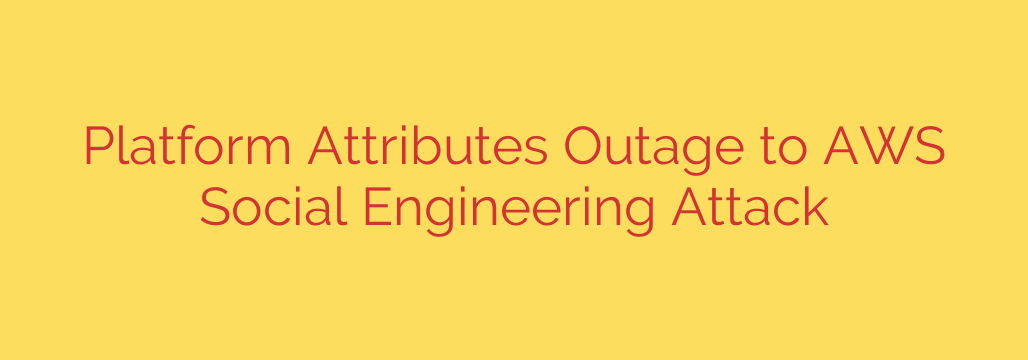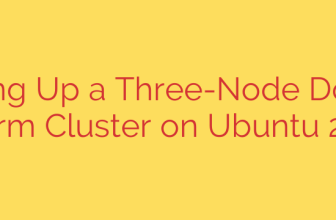
The Human Element: Anatomy of a Cloud Supply Chain Cyberattack
In the world of cybersecurity, we often focus on complex code and sophisticated firewalls. But a recent, high-profile service outage serves as a stark reminder that the biggest vulnerability isn’t always digital—it’s human. A sophisticated attack recently brought down a major cloud platform, not by exploiting a software flaw, but by manipulating a person. This incident is a critical case study in the growing threat of social engineering within the cloud ecosystem.
A Breakdown of the Incident
A prominent Platform-as-a-Service (PaaS) provider recently experienced a significant outage that impacted customers worldwide. The root cause was not an internal error or a direct assault on their infrastructure. Instead, malicious actors targeted an employee at their cloud services provider, Amazon Web Services (AWS).
Through a carefully orchestrated social engineering scheme, the attackers successfully tricked an AWS support employee. This deception allowed them to gain unauthorized access to the PaaS provider’s management console. Once inside, the attackers acted swiftly and destructively, deleting a large amount of production data and critical infrastructure, triggering the widespread service disruption.
While the platform’s team worked tirelessly to restore services from backups, the event highlights a terrifying reality: your organization’s security is only as strong as the security of your critical vendors.
The Real Culprit: Social Engineering in the Cloud
This attack is a textbook example of a supply chain attack amplified by social engineering.
- Social Engineering is the art of psychological manipulation to trick individuals into divulging confidential information or performing actions they shouldn’t. Instead of breaking down a digital door, attackers simply convince someone with the keys to open it for them.
- A Supply Chain Attack targets a trusted third-party vendor or partner to gain access to their clients. By compromising one provider, attackers can impact hundreds or thousands of downstream customers.
In this case, the attackers didn’t need to find a vulnerability in the PaaS provider’s code. They identified a weaker link in the chain—the human element at the cloud provider—and exploited it to devastating effect.
Why This Incident is a Wake-Up Call for Everyone
This event underscores a fundamental shift in the threat landscape. As technical defenses become stronger, attackers are increasingly focusing their efforts on people. It serves as a crucial warning for any organization that relies on cloud services.
The traditional “shared responsibility model” in the cloud—where the provider secures the cloud and the customer secures what’s in the cloud—is being tested. This incident proves that a breach at the provider level can directly and catastrophically impact the customer, regardless of how well the customer has secured their own environment. It demonstrates that even with robust internal security, a vulnerability in your vendor’s human processes can become your crisis.
Actionable Steps to Protect Your Organization
While you can’t control the internal security training of your vendors, you can take proactive steps to mitigate the risk and limit the potential damage from a similar attack.
Implement Strict Multi-Factor Authentication (MFA) Everywhere: This is non-negotiable. MFA is one of the most effective controls to prevent unauthorized access, even if credentials are stolen. Ensure it is enabled for all users, especially those with privileged access to cloud consoles and critical systems.
Adopt the Principle of Least Privilege (PoLP): Grant users and systems only the minimum level of access required to perform their jobs. By limiting permissions, you limit the “blast radius” of a compromised account. An attacker with access to a low-privilege account can do far less damage than one who gains control of a root or admin account.
Vet Your Vendors and Understand Their Security Posture: Ask your critical vendors hard questions. How do they protect against social engineering? What are their access control policies for support staff? Understanding their security protocols is just as important as understanding their service level agreements (SLAs).
Enhance Internal Employee Training: Your own team is your first line of defense. Conduct regular, realistic training on recognizing and reporting phishing attempts, vishing (voice phishing), and other social engineering tactics. A well-informed employee is far less likely to become an unwitting accomplice.
Maintain and Test Robust Backup and Recovery Plans: In this incident, backups were the only reason the provider could recover. Immutable, offline, or off-site backups are your last line of defense against data destruction. Regularly test your disaster recovery plan to ensure you can restore operations quickly and effectively when the worst happens.
The Path Forward: A Stronger Security Posture
The key takeaway is clear: technology alone is not enough. As attackers refine their ability to exploit human trust, organizations must build a culture of security that extends from their own employees to the partners they rely on. This incident is not about placing blame, but about learning a vital lesson. True cyber resilience requires a multi-layered defense that addresses technical vulnerabilities and, most importantly, the enduring human element.
Source: https://go.theregister.com/feed/www.theregister.com/2025/10/02/subpoena_tracking_platform_outage_blamed/








